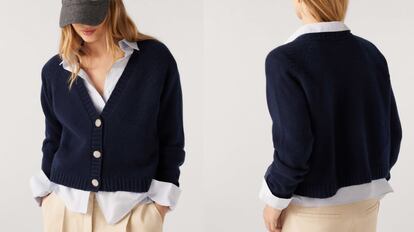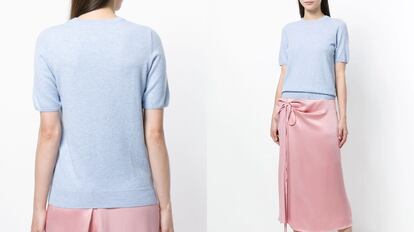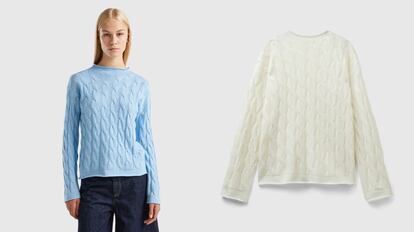Tips and tricks to care for your cashmere garments
Is it better to wash them by hand? What can you do about moths? An expert answers all your questions about this delicate fabric

Suede, leather and cashmere garments require a considerable financial investment, and their owners also have to devote more time to their care. Being very delicate fabrics, it is important to take a series of specific precautions if we want to extend their useful life as much as possible. In the case of cashmere – a natural fiber used in sweaters, scarves and jackets – the most common doubts have to do with how to wash them so that they do not shrink, as well as where to store them so moths do not get to them.

How to care for a cashmere sweater
Rosa Moreno Laorga, trend analyst, fashion consultant and teacher at the Istituto Europeo di Design in Madrid, Spain, explains: “Cashmere garments are delicate, so it is important to keep them folded (in the case of tops or sweaters) and not put them on a hanger, because they could deform and stretch over time, with the neck, neckline and sleeves losing their shape. When the seasons change, it is best to bag them to avoid external aggression, such as moths.”

As for the moths, Laorga, author of the essay on the origin of trends Hacer de lo cotidiano un ritual contemporáneo (Turning the everyday into a contemporary ritual), points out that “bags with lavender seeds have been proven to deter these insects,” so placing a few in your drawers and closets is a good idea.
In addition, she recommends “checking our wool or cashmere garments with certain periodicity, since moths have a predilection for natural fibers and it is easy for them to pass from one to another, so if we find an infected garment we must discard it immediately.”

How to wash cashmere clothes
Laorga explains that this process “will depend on the type of garment and the manufacturer’s instructions.” For example, “in the case of jackets or coats, dry cleaning is appropriate.”
In the case of pure cashmere garments, “hand washing is better than using the washing machine, always with cold water and specialized products (the main brands of cleaning products offer detergents for hand washing),” says the expert. Also, “when rinsing these garments, it is preferable to apply gentle pressure to remove excess moisture and then wrap them in a towel to finish the operation without straining the fibers.”

Finally, in garments in which “cashmere is mixed with chemical fibers, machine washing is allowed, following the program indicated on the label,” says Laorga.
In recent years, electric or manual lint removers have become popular to eliminate those little fuzz balls that give clothes an unkempt, unsightly appearance. But are those recommended for cashmere garments? The fashion specialist explains that, in reality, “garments made from this type of wool don’t produce that kind of fuzz. Depending on whether the garment is knitted or woven, we can find a slight fluff that covers the garment and is part of the material, giving it that classic fluffy, sometimes shiny appearance. These instruments are very useful for thicker fabrics, but not for cashmere.”

How to recognize a quality cashmere sweater
In a world with an abundance of low-cost fashion, it is not always easy to tell if a garment really is what it says it is. “If the cashmere is not mixed with chemical fibers, that is, if its composition is pure, we first of all assume that it is an exclusive, high-quality garment, regardless of the brand, as cashmere is a scarce natural fiber (to make a sweater, more than one sheep needs to be sheared).”
In addition, “another of its characteristics is the density of the yarn itself, which is why this material provides instant warmth. By simply placing the garment on our skin we can notice an immediate thermal variation, in addition to the lightness.”

Sign up for our weekly newsletter to get more English-language news coverage from EL PAÍS USA Edition
Tu suscripción se está usando en otro dispositivo
¿Quieres añadir otro usuario a tu suscripción?
Si continúas leyendo en este dispositivo, no se podrá leer en el otro.
FlechaTu suscripción se está usando en otro dispositivo y solo puedes acceder a EL PAÍS desde un dispositivo a la vez.
Si quieres compartir tu cuenta, cambia tu suscripción a la modalidad Premium, así podrás añadir otro usuario. Cada uno accederá con su propia cuenta de email, lo que os permitirá personalizar vuestra experiencia en EL PAÍS.
¿Tienes una suscripción de empresa? Accede aquí para contratar más cuentas.
En el caso de no saber quién está usando tu cuenta, te recomendamos cambiar tu contraseña aquí.
Si decides continuar compartiendo tu cuenta, este mensaje se mostrará en tu dispositivo y en el de la otra persona que está usando tu cuenta de forma indefinida, afectando a tu experiencia de lectura. Puedes consultar aquí los términos y condiciones de la suscripción digital.
More information
Últimas noticias
Most viewed
- Reinhard Genzel, Nobel laureate in physics: ‘One-minute videos will never give you the truth’
- Pablo Escobar’s hippos: A serious environmental problem, 40 years on
- Charles Dubouloz, mountaineering star, retires at 36 with a farewell tour inspired by Walter Bonatti
- Why we lost the habit of sleeping in two segments and how that changed our sense of time
- The fall of a prolific science journal exposes the billion-dollar profits of scientific publishing











































